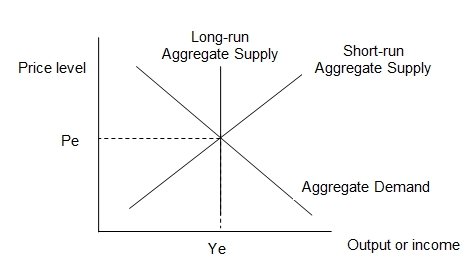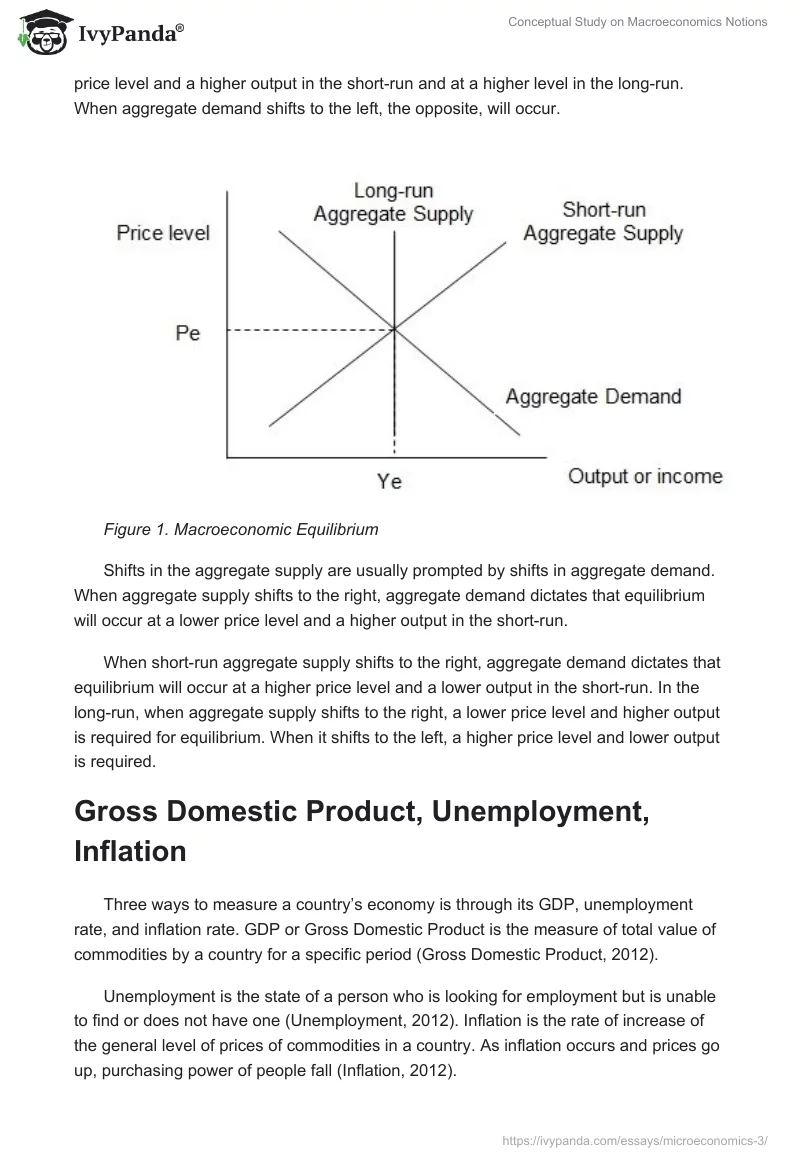Supply and Demand
Supply and demand are the economic model of determining prices in a competitive market, wherein supply refers to the quantity of commodities available in the market and demand refers to the quantity demanded by consumers. The law of demand states that the higher the costof the good or service, the less people will demand it, while the law of supply states that the higher the price of a commodity, the higher the quantity required (Supply and demand, 2012).
Macroeconomic Equilibrium
Macroeconomic equilibrium is a condition of a nation’s economy wherein aggregate demand is met by aggregate supply (Macroeconomic equilibrium, 2012). The total demand of a final good or service in the economy is called its aggregate demand, while the total supply of a final goods and services the economy plans to sell is called the aggregate supply. Significant changes on demand or supply will affect prices, employment, and resources of a nation.
How Aggregate Demand and Aggregate Supply Determine Equilibrium Price and Output In The Short- and Long-Run
Macroeconomic equilibrium is computed by relating national price level with national output. The market is in equilibrium when price and output are equal.
Changes in the price or output of a commodity prompts shifts in its aggregate demand and/or aggregate supply. In general, expansionary policies shift aggregate demand to the right while contracting policies shift it to the left. Looking at the diagram below, when aggregate demand shifts to the right, equilibrium will occur at a higher price level and a higher output in the short-run and at a higher level in the long-run. When aggregate demand shifts to the left, the opposite, will occur.

Figure 1. Macroeconomic Equilibrium
Shifts in the aggregate supply are usually prompted by shifts in aggregate demand. When aggregate supply shifts to the right, aggregate demand dictates that equilibrium will occur at a lower price level and a higher output in the short-run.
When short-run aggregate supply shifts to the right, aggregate demand dictates that equilibrium will occur at a higher price level and a lower output in the short-run. In the long-run, when aggregate supply shifts to the right, a lower price level and higher output is required for equilibrium. When it shifts to the left, a higher price level and lower output is required.
Gross Domestic Product, Unemployment, Inflation
Three ways to measure a country’s economy is through its GDP, unemployment rate, and inflation rate. GDP or Gross Domestic Product is the measure of total value of commodities by a country for a specific period (Gross Domestic Product, 2012).
Unemployment is the state of a person who is looking for employment but is unable to find or does not have one (Unemployment, 2012). Inflation is the rate of increase of the general level of prices of commodities in a country. As inflation occurs and prices go up, purchasing power of people fall (Inflation, 2012).
Business Cycles and Economic Growth
Business cycles are series of patterns affected by employment, industrial productivity, and interest rates that show the expansion and contraction of economic activities. There are five stages on a business cycle, namely, growth, peak, recession, trough, and recovery (Business Cycle, 2012).
Economic growth is the measure of an economy’s increase of commodity and capacity to accommodate its population within a period of time (Economic Growth, 2012).Productivity, inflation, population growth and introduction of new commodities in the economy are factors of economic growth.
Multiplier Concept
Multipliersare factors that quantify the changes of capital investment to total income of an economy. They are used to measure the effects of government spending on income. Multipliers are calculated by dividing the marginal propensity to save to one (Multipliers, 2012).
John M. Keynes was made the second father of economics after Adam Smith because of his contribution on multipliers. The limitations of the multiplier concept include its restriction to economies (It is only for closed economies.), its lack of social factors, and its low adaptability to change.
Fiscal Policy
Fiscal policy is a government policy that deals with the spending activities of the government that influences macroeconomic conditions. These policies are concerned and implemented in taxation, interest rates, transfer payments, and borrowing (Fiscal policy, 2012).
Two tools of fiscal policy are the Automatic Stabilizers, attributes of fiscal policy that smooth instability in consumption over the business cycle, and the Discretionary Fiscal Policy, the conscious manipulation of implementation of taxation, purchases, transfers, and borrowings. An example of this is the Federal Income Tax (Kelly, n.d.).
Macroeconomics in Contemporary Economic Issues
As previously mentioned, business cycles have five stages, namely, its growth, peak, recession, trough, and recovery. In recent years, however, the flow of the stages in the cycle is unsteady, not following the regular cycle. This is because of the impact of improbable events not forecasted (or were not heard of) by economist.
One significant event in recent time is the sharp decline in housing prices, resulting in a recession in the economy. This event in economy happened in 2007. Before the year, housing prices grew rapidly and collapsed by nearly 20 percent over the next two years, due to low interest rates in the 2000s, and lowering lending standards.
Another macroeconomic event in recent times is the rise of prices of oil and other basic commodities, such as natural gas, steel, corn, wheat, rice, and coal. Oil consumption in the United States lessened in the first half of 2008 (Jones, 2008). This was offset, however, by the oil consumption of China, India, and the Middle East, which resulted in an outward shift in demand. This occurrence created a chain of price increases on basic commodities.
Reference List
Business cycle.(2012). Investor words. Web.
Economic growth.(2012). Investopedia. Web.
Gross domestic product.(2012). Merriam-webster online. Web.
Inflation .(2012). Investopedia. Web.
Jones, C. I. (2008). Current macroeconomic events. W. w. Norton. Web.
Kelly, T. Chapter 12 fiscal policy. Baylor business. Web.
Macroeconomic equilibrium. (2012). Business dictionary. Web.
Multipliers. (2012). Investopedia. Web.
Supply and demand. (2012). Encyclopædia britannica. Web.
Unemployment. (2012). Investopedia. Web.


